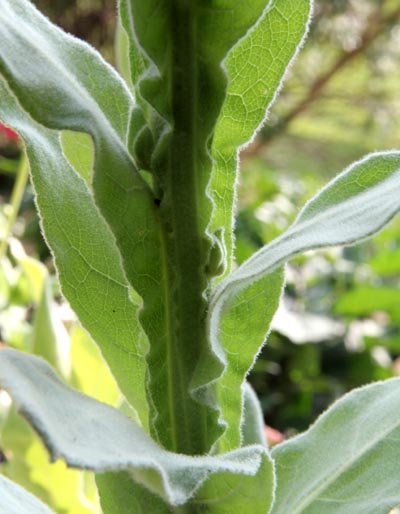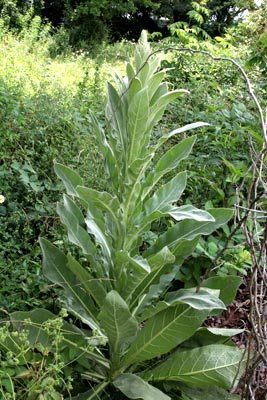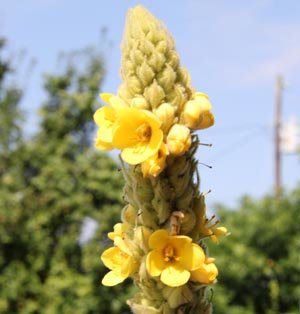





Some of our most unusual weeds have a colorful and interesting history.
This is the time of year when we start to see the bloom stalks of great mullein reach for the sky. This native of Europe and the Middle East goes from an insignificant rosette of grayish leaves to a spectacular plant that commands attention. In sunny, well-drained spots they steal the show over lesser weeds.
 Great Mullein, Verbascum thapsus is a biennial herb/weed that grows almost anywhere, but seems to have an affinity for 'difficult' conditions. It appears just as happy growing out of a crack in sun-baked rocks or along a busy roadway as opposed to being a garden prima donna with a long list of cultural demands. This engineering marvel of the plant world has an unique leaf arrangement that makes use of all available water. The leaves form clasping channels along the stem that funnels water down toward the roots. The leaves are smaller toward the top of the plant, so any moisture not channeled to the center automatically drops on to the larger lower leaves and ultimately works its way toward the stem. The fuzzy leaves also assist the mullein in its quest for water since the hairs 'shade' the leaf and prevents excess evaporation. This is a common feature for many drought-tolerant plants.
Great Mullein, Verbascum thapsus is a biennial herb/weed that grows almost anywhere, but seems to have an affinity for 'difficult' conditions. It appears just as happy growing out of a crack in sun-baked rocks or along a busy roadway as opposed to being a garden prima donna with a long list of cultural demands. This engineering marvel of the plant world has an unique leaf arrangement that makes use of all available water. The leaves form clasping channels along the stem that funnels water down toward the roots. The leaves are smaller toward the top of the plant, so any moisture not channeled to the center automatically drops on to the larger lower leaves and ultimately works its way toward the stem. The fuzzy leaves also assist the mullein in its quest for water since the hairs 'shade' the leaf and prevents excess evaporation. This is a common feature for many drought-tolerant plants.
 Great mullein has been important as an herbal remedy for centuries and and it actually has measurable medicinal properties. Colonists brought it to the New World in the 1600's and it didn't take long for the native peoples to discover uses for it. Tea made from the leaves and flowers helped sooth respiratory ailments. It is an effective expectorant that helps coughs become more productive. It also has antiviral and anti inflammatory properties. An infusion made from steeping the leaves in oil has been an ear ache remedy for generations. All parts of the plant, including the roots have been used medicinally and it contains no poisonous compounds. The hairs on the leaves might cause a bit of irritation in some people, but the plant is fairly benign. Over the centuries various teas, salves, smoke and infusions have been prescribed for everything from insanity to hiccups.
Great mullein has been important as an herbal remedy for centuries and and it actually has measurable medicinal properties. Colonists brought it to the New World in the 1600's and it didn't take long for the native peoples to discover uses for it. Tea made from the leaves and flowers helped sooth respiratory ailments. It is an effective expectorant that helps coughs become more productive. It also has antiviral and anti inflammatory properties. An infusion made from steeping the leaves in oil has been an ear ache remedy for generations. All parts of the plant, including the roots have been used medicinally and it contains no poisonous compounds. The hairs on the leaves might cause a bit of irritation in some people, but the plant is fairly benign. Over the centuries various teas, salves, smoke and infusions have been prescribed for everything from insanity to hiccups.
The tall flower spikes were dipped in tallow and used as candlewicks and torches, while the dried leaves were carried by many peoples over the centuries as a perfect fire tinder. The yellow flowers make a beautiful yellow dye that also did double-duty as a blond hair rinse.
 There is conflicting lore regarding these ready made torches, some legends say that witches preferred them to other material for their torches and other stories say that by burning them in your house, their charm will keep witches and evil spirits away away. The Romans believed that the leaves placed around the openings in a home would repel demons and it is said that Ulysses used it against Circe's magic potion (it was called 'moly' in the Odyssey) so he could rescue his crew who Circe had turned into pigs. Another folktale from the British Isles states that if you bend the flower stalk toward the home of your intended, you could tell if the lover was faithful. If the stalk returned to an upright position, your lover was true, if it stayed bent, then they were cheating.
There is conflicting lore regarding these ready made torches, some legends say that witches preferred them to other material for their torches and other stories say that by burning them in your house, their charm will keep witches and evil spirits away away. The Romans believed that the leaves placed around the openings in a home would repel demons and it is said that Ulysses used it against Circe's magic potion (it was called 'moly' in the Odyssey) so he could rescue his crew who Circe had turned into pigs. Another folktale from the British Isles states that if you bend the flower stalk toward the home of your intended, you could tell if the lover was faithful. If the stalk returned to an upright position, your lover was true, if it stayed bent, then they were cheating.
Plant mullein in a well drained sunny area and give it room to spread. The first year, the rosettes will form. The second year, the flower stalks, then the plant dies. Don't worry, mullein makes thousands of seeds and it will cheerfully reseed for years, just remember to give it plenty of sun and space.
Copyright © www.100flowers.win Botanic Garden All Rights Reserved